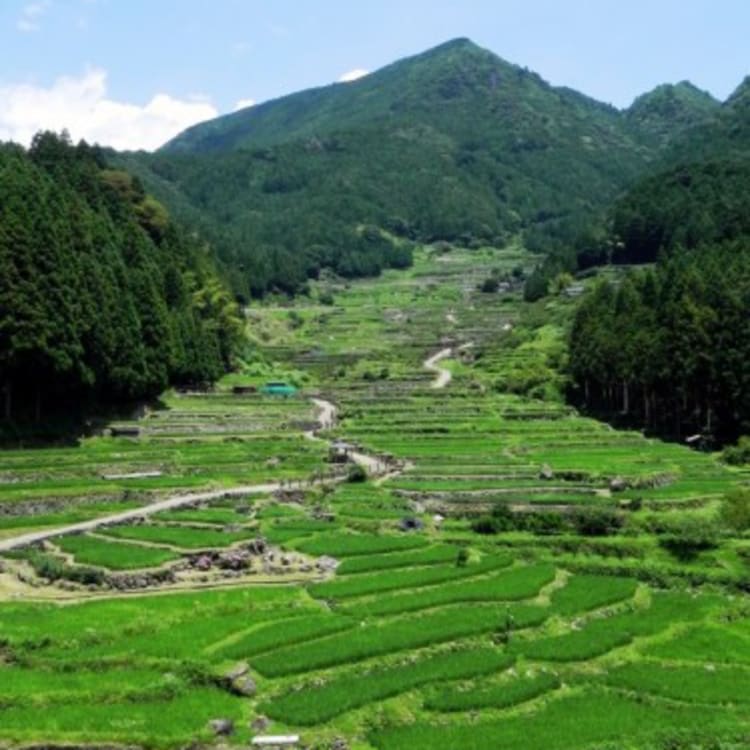
GUIDE Yotsuya Senmaida Rice terraces, Aichi by JNTO on 19 December 2018

For a balance of history and nature, Aichi prefecture hits a sweet spot. From the famous Nagoya Castle and to the Tokugawa Art Museum with its thousands of artefacts, the region is home to numerous cultural treasures.
There are also natural sites like Minami Chita Hot Spring Village which consists of the seaside villages of Utsumi, Yamami and Toyohama which are famous for their abundance of hot spring water. However, a natural gem is undoubtedly the Yotsuya Senmaida rice terraces.
About 400 years old, terraced rice paddies are known as Senmaida, or “1,000 Rice Terraces”. In Yotsuya, there are in fact nearly 1,300 of them crowded on a hillside that stretches only 90 square metres. There are steep elevations between the fields – some nearly as high as a 200m apart – which means there are spectacular views from the higher terraces.
An incredible amount of patient and laborious engineering went into these time-tested behemoths; the rock walls were painstakingly slotted into the hillside over decades, some 400 years ago. The steep topography means modern farming machinery can’t be used, so farmers have to use their hands to perform even the most laborious tasks. It’s not easy to maintain and cultivate on these terraced fields, but even so, about 30 local rice farmers continue to till the land to produce high quality rice.
Where can you find Yotsuya Senmaida?
Most of Japan’s few remaining Senmaida are located out in the middle of nowhere, and the Yotsuya rice terraces are no different. Located on the outskirts of Shinshiro City, at the foot of Mt. Kurakake, they provide a unique and fascinating scene of traditional farming techniques, developed through a need for land, and greater rice crops.
While beautiful, the Senmaida can be difficult get to, and facilities are few and far between. Because of this, they are pretty much under-appreciated, and rarely visited. But you do find yourself in the area, they’re well worth a visit, no matter the season.
Water from Mt. Kurakake fills the fields in spring, lending a shining veneer to the fields in the sunlight. This is when numerous rice planting festivals are hosted by the locals; held in the paddies themselves, you can see locals enjoying a hearty song and dance – some wearing traditional costumes. Visitors are also encouraged to participate in the planting, so if you don’t mind getting damp and dirty, hop right in and enjoy rural hospitality!
By summer, the fields would be a rich verdant green as far as the eye can see. The colour tones shift to a golden yellow in autumn, and it’s still beautiful in winter with snow filling in the neat terraces in the landscape.
While the terraced fields are not easily accessed via public transport, it’s worth the journey as it’s a rare opportunity to see traditional farming practiced as it was hundreds of years ago.
What’s good to eat in Aichi Prefecture?
The painstaking care the farmers lavish on their rice fields results in some of the finest rice in Japan. As such, the region is also a great place to indulge in rice-based cuisine.
Nagoya City is proud of their hitsumabushi – chopped seafood on rice – that is traditionally served in a wooden rice tub. Savour the prefecture’s specialty eel, grilled on a skewer and chopped into the hitsumabushi.

Nagoya is also known for ten-musu, or battered prawn pressed into a small rice ball. The rice is slightly salted – a perfect accent for the juicy, succulent and slightly sweet prawn. Another popular snack is the inarizushi – sushi rice wrapped in sweet fried tofu skin – which is popular in nearby Toyokawa City; the city hosts a competition to judge the best inarizushi of the year.
For a hearty lunch, grab a misokatsu – a delicious pairing of a pork katsu cutlet with thick, savoury miso sauce. The legend of the dish is as fanciful as it tastes – once, in the 1940s, a street stall customer accidentally dipped his katsu in a thick miso stew, and raved about the delicious combination.
Goheimochi is a ubiquitous and established part of Aichi’s culinary culture – this delicious grilled ricecake available in street stalls everywhere in the prefecture. The simple flavour of this rice treat is given a boost from the miso, soy, or sesame sauce slathered on top, and is best enjoyed hot.

How do you get to Yotsuya Senmaida?
The terraces have multiple access points, but it’s easiest from Hon-Nagashino Station, which is accessible via the JR Iida Line from Toyohashi Station. From Hon-Nagashino Station, you can take the Toyotetsu Bus headed for Yotsuya Senmaidaguchi (30 minutes) and walk about 15 minutes to the fields. Or you can take the Toyotetsu Bus bound for Taguchi (25 minutes), alight at "Takiue" and walk for about 40 minutes. By car, it can be reached within an hour from the nearest exit of the Tomei Expressway.
Date: Anytime
Time: Anytime
Entrance fee: Free
























































